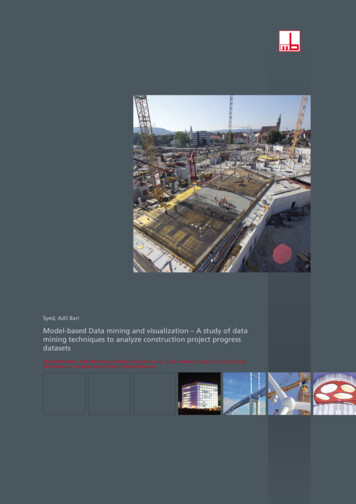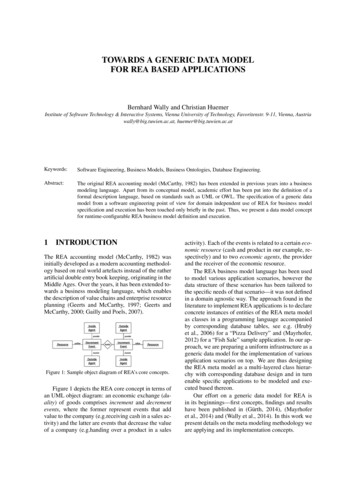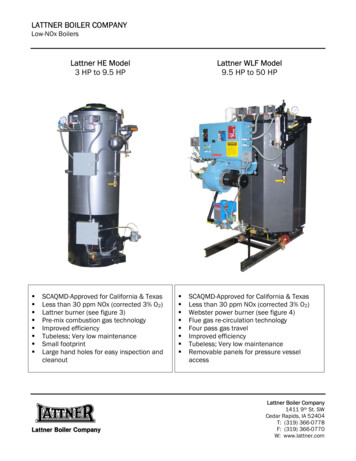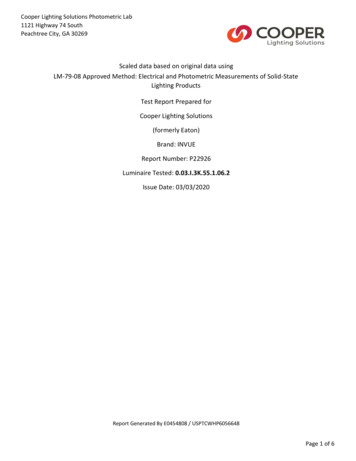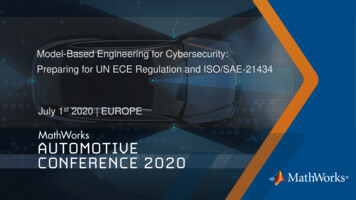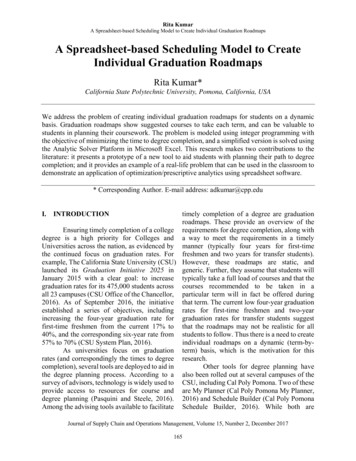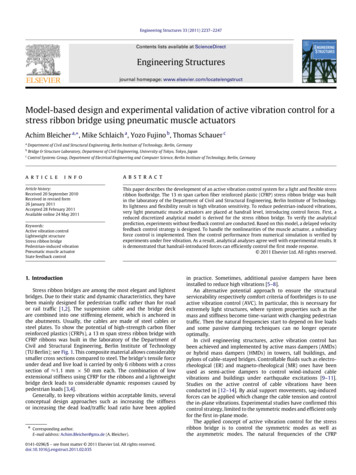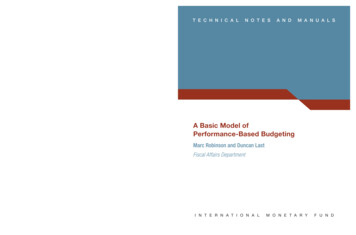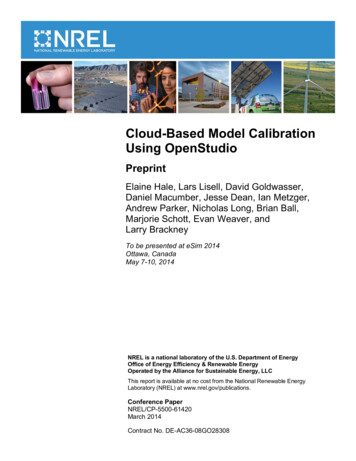
Transcription
3D Model-Based Data Augmentation for Hand Gesture RecognitionBen LimonchikStanford UniversityGuy AmdurStanford Abstractsive and very time consuming process in deep learning studies, we attempted to test whether generating fake imageson Unity in a quick and relatively cheap manner could beused to outperform networks that rely only on real images.Please note that the testing set was kept the same (i.e. onlyreal images) to ensure that any accuracy improvements areconsistent with real life examples.This project focuses on classifying hand gestures andimproving the testing accuracy using virtual 3D modelsto augment the original limited dataset. An existing workdone on this classification problem and dataset uses a constrained generative model to predict hand gestures. Thegoal of this project was to explore how generating new virtual data from 3D models can augment the original datasetto improve CNN models’ performances. We experimentedwith various custom CNN architectures as well as pretrained models such as VGG-16 and Inception-ResNet-v2in order to optimize our classification. We used learningvisualizations techniques in order to inform how we generated new virtual 3D data. By using the original real training dataset and the new virtual 3D training dataset we wereable to outperform the original work done on this problem,reaching over 96% testing classification accuracy.2. Related WorkInteresting work has been done to solve the hand gesturerecognition problem as documented in references [2], [3]and [17].One paper by Sebastien Marcel [7] uses a neural network approach to classify hand gestures. Marcel first creates the dataset by segmenting the hands from a full-bodyimages using a space discretisation based on face locationand body anthropometry. The body-face space is built usingthe anthropometric body model expressed as a function ofthe total height itself calculated from the face height.Next, Marcel uses a neural network model which had already been applied to face detection: the constrained generative model (Figure 1). The constrained generative learningtries to fit the probability distribution of the set of hands using a non-linear compression neural network and non-handexamples. Each hand example is reconstructed as itself andeach non-hand example is constrained to be reconstructedas the mean neighborhood of the nearest hand example.Then, the classification is done by measuring the distancebetween the examples and the set of hands.1. IntroductionHand Gesture recognition has a wide variety of applications. Sign language is the primary way more than 70 million deaf people communicate with non-deaf people. Beingable to automatically translate hand gesture to text can facilitate deaf to non-deaf communication. In this project weare investigating the problem of identifying six hand gestures representing letters and numbers in the sign language.Furthermore, as Virtual Reality is increasingly gainingpopularity, the ability to carefully recognize what hand gesture the user is using is crucial to ensure a reasonable andsmooth user experience. Hand interaction is a main component in the VR/AR industry and hand tracking is essentialfor this kind of virtual interaction.To tackle this problem our neural networks take in a setof hand images with a variety of backgrounds and outputsthe scientific name of the hand gesture. Since our datasetincluded only 4872 training images, we attempted to generate virtual data from realistic 3D hand models using theUnity game engine in order to outperform networks trainedon real data only. Since data collection is often an expen-Figure 1: Constrained generative modelMost of the hand gesture database was used for training1
tivations throughout a network to take on a unit gaussiandistribution at the beginning of the training. The fully connected layer, usually at the end of the network, introducesadditional parameters and also allows us to reshape the output of the convolutional layers into the desired number ofclasses. Furthermore, in every few convolutional layers weadded 2-by-2 maxpooling layers in order to reduce the dimensionality of the following layers and especially reducethe number of parameters of the last few fully connectedlayers.Finally, we used a softmax loss also sometimes referredto as negative log-likelihood loss. The softmax loss (Figure3) uses the raw scores of the input image in order to measurethe probability of the image being classified as one of the sixpossible hand gestures.and the remainder was used for testing. Although the images with complex backgrounds are more difficult to learn,the CGM achieves a good recognition rate and a small falsealarm rate (Table 1 and 2 in Figure 2). Our goal was toachieve better results on the same dataset used in Marcel’spaper using more advanced CNN architectures.Figure 3: Softmax lossFigure 2: Accuracies per model for the Marcel experiment3.2. VGG-16 NetworkOther works we reviewed in preparation of this paper include NVIDIA’s Hand Gesture Recognition with 3D Convolutional Neural Networks [8], Althoff’s Robust multimodalhand-and head gesture recognition [1] and E. Ohn-Bar’s[11]. These researches informed our approach to customizing CNN networks however they used much larger datasetsof which not all of them were public and they were specificto car drivers and thus were irrelevant to our data augmentation problem.Finally, in preparation of this paper we have either referred to or skimmed the following relevant works: [4], [5],[6], [13], [10], [9], [20], [12] [15] [19]VGG is a relatively new 16-layer CNN architecture developed at the University of Oxford in 2014 [14]. Duringtraining, the input to the network is a fixed-size RGB image. The only preprocessing done is subtracting the meanRGB value, computed on the training set, from each pixel.The image is passed through a stack of convolutional layers, where the network uses filters with a very small receptive field of 3x3 (which is the smallest size to capturethe notion of left/right, up/down, center). The convolutionstride is fixed to 1 pixel; the spatial padding of the convolutional layer input is such that the spatial resolution ispreserved after convolution, i.e. the padding is 1 pixel for3x3 convolutional layers. Spatial pooling is carried out byfive max-pooling layers, which follow some of the convolutional layers (not all the convolutional layers are followedby max-pooling). Max-pooling is performed over a 2x2pixel window, with stride 2.A stack of convolutional layers (which has a differentdepth in different architectures) is followed by three fullyconnected (FC) layers: the first two have 4096 channelseach, the third performs 1000-way ILSVRC classificationand thus contains 1000 channels (one for each class). The final layer is the soft-max layer. The configuration of the fullyconnected layers is the same in all networks. All hidden layers are equipped with the rectification (ReLU (Krizhevskyet al., 2012)) non-linearity. See Figure 4 for a VGG-16 network diagram.3. Methods3.1. Customized CNN ArchitecturesAfter conducting a literature review, we came up with afew CNN architectures that we wanted to test. These architectures differ in the type and number of layers chainedtogether. We use several combinations of convolutional,ReLU, batch-normalization and fully connected layers.Using repeated convolutional layers with a small filter size allows us to increase the effective receptive fieldfor each neuron whilst keeping the computational expense manageable. The ReLU activations introduce nonlinearities and offer sparse activation and efficient gradientback-propagation. The batch-normalization forces the ac2
Figure 4: VGG-16 Network Diagram(b) Stem Layer3.3. Inception-ResNet-v2 NetworkThe Inception-ResNet-v2 network is a CNN network architecture developed at Google in 2016 [16]. The networkcombines two of most recent ideas: Residual connectionsintroduced by He et al. and the latest revised version ofthe Inception architecture suggested by Google. It is argued that residual connections are of inherent importancefor training very deep architectures. Since Inception networks tend to be very deep, it is natural to replace the filterconcatenation stage of the Inception architecture with residual connections.The residual version of the Inception networks usescheaper Inception blocks than the original Inception. EachInception block is followed by filter-expansion layer (1x1convolution without activation) which is used for scalingup the dimensionality of the filter bank before the addition to match the depth of the input. Another small technical difference between the residual and non-residual Inception variants is that the Inception-ResNet uses batchnormalization only on top of the traditional layers, but noton top of the summations. Finally, the Inception-ResNetv2 network scales down the residuals before adding them tothe previous layer activation to stabilize the training.(a) Network DiagramFigure 5: Inception-ResNet-v2 ArchitectureFigure 6: Inception-ResNet-A layerFigure 7: Inception-ResNet-B layer4. Datasets4.1. Marcel DatasetThe hand gesture dataset we used from Marcel’s paperis composed of six different hand gestures called: a, b, c,point, five, and v (see image samples below). The datasetwas collected from ten different people, eight of which wereused for training data and the other two are used for testingdata. All images are of size 77x66 pixels. The testing setis further broken down into two groups: ’uniform’ imagesand ’complex’ images. In the ’uniform’ testing images theFigure 8: Inception-ResNet-C layerimage of the hand gesture is taken with a white backgroundin order to simplify the classification problem. On the otherhand, in ’complex’ testing set the images of the hand gestures are taken on top of a variety of colorful backgrounds.3
4.2.1(a) Uniform backgroundRendering with Unity3DUnity3D is a game engine capable of creating realistic 3Dgraphics in realtime. Compared to non-realtime 3D rendering software such as 3Ds Max or Blender it producesless realistic imagery. However, this was not an issue sincethe output images would have a resolution of 76x66, whichmeans that quality improvements of the non-realtime renderer would be barely visible anyway. Therefore, a realtimerenderer is a better choice in this case because of its immense rendering speed compared to the alternatives.(b) Complex backgroundFigure 9: Testing imagesThe complex test set is much more difficult to classifysince the neural network needs to learn the pattern of thehand itself despite the complexity of the colorful background. As can be seen in table 1, there is an unequalamount of sample images from each 57382Testing(Complex)394147585438277Figure 10: The Unity editor window4.2.2Realistic Scene SetupThe base scene in Unity was set up to resemble the generallayout of the real dataset as close as possible. The sceneconsisted of the hand model in the center and a plane covering the entire field of view at the back. The backgroundplane had an actual photograph as a texture to improve realism. A single directional light source resembling the sunor an interior ceiling light was placed pointing down towardthe hand in the scene.The hand model was chosen for its realistic mesh andtextures downloaded from Blend Swap [18]. Also, themodel was rigged, meaning that the actual mesh can be controlled indirectly by manipulating a skeleton structure andits joints instead of the vertices of the mesh.The hand model was posed to line up with the six different gesture classes already present in the Marcel dataset.Table 1: Number of data points of each GestureA training dataset of 4872 images is clearly not enoughfor this type of deep learning task. Therefore we attemptedto generate additional images using artificial methods asdiscussed below. Note that for as our validation set we used300 randomly samples images from the training dataset.4.2. 3D Model-Based DatasetSince data collection is an expensive part of deep learning, we had decided to take another approach for additionaldata collection. By generating additional data from 3D representations we got a cheap way of collecting additional,albeit virtual data. There were a few key conditions that thegenerated images had to fulfill.4.2.3Varying Photo ConditionsFor each new virtual image, a number of parameters weremanipulated in the scene. The joints in the hand were randomized within a smallrange of angles, making the hand pose look slightlydifferent for each image. Be faster and cheaper to generate than actual photos. Look as close to the actual photos as possible. The placement of the hand (as well as its rotation)within the image frame was randomized, increasingthe variance of the dataset and hopefully improving theCNN’s robustness to hand placement. The photos must vary in lighting conditions, handpose, skin color, finger placement etc.4
The background image was randomly chosen froma set of interior photographs with various furniture,lighting conditions and color.Given the small real dataset we have, we expected thatnetworks with less fully connected layers and more convolutional layers would perform better on our classificationproblem. This expectation was confirmed by the first fewmodels we trained which had multiple fully connected layers. Therefore, in later versions we tried to use more convolutional layers and smaller fully connected layers. We further introduced pooling layers to our models in order to decrease the dimensionality of the last fully connected layersand thus reduce the overall number of parameters in our network. Nevertheless, we observed that our testing accuracydidn’t increase as we added more and more convolutionallayers. We tested networks with one to four convolutionallayers and found that the testing accuracy drops below twoand above two convolutional layers. Therefore, moving forward we developed our next networks with two convolutional layers. The intensity and angle of the sunlight was randomized, increasing variance of lighting conditions withinthe virtual dataset. Note: light was the variable weplayed most with when generating virtual trainingdata. We did so as a result of our findings usingSaliency maps (see more explanation in section 5.1.1).5.1.1(a) Gesture AData VisualizationIn order to better understand what our network learned wevisualized the weights of the first convolutional layer. Mostof the visualization were similar to those on figure 12 whichdo indicate that some body-colored blobs are learned butthey were not very informative beyond that.(b) Gesture BFigure 11: Virtual images generated using 3D software5. Experiment5.1. Building customized architecturesIn order to classify the test hand gestures we began by experimenting with a variety of custom neural network architectures in order to find an optimal network to fit our data.Table 2 summarizes the different architectures we tested:Architectures[FC]-[FC]-[Softmax Loss][Conv-Relu]-[FC] 2[Softmax Loss][Conv-Relu] 2-[FC] 3[Softmax Loss][Conv-Relu] 3-[FC] 3[Softmax Loss][Conv-Relu] 4-[FC] 1[Softmax Loss][Conv-Relu-BN-pool] 2[FC] 1-[Softmax Loss][Conv-Relu-BN-dropoutpool] 2-[FC] 1[Softmax Loss]Average testing accuracy18.2%37.9%Figure 12: Weights Visualization52.3%On the other hand, we used saliency maps in order tofind the most important regions in our training images forthe classification problem. As seen by figure 13 we foundout as we expected that the region of the hand in the image was very important for the classification task. Interestingly we noticed that light was also extremely important(i.e. intense red regions) to the classification problem. Thisis the reason why we decided to generate virtual 3D trainingdatasets where we moved around the location of the lightsource while keeping the hand still. We did so in order tobe able to feed the network images of the same hand gesture with shadows in different directions. We expected thatthis change will make our network more robust to light an-41.2%39.2%56.9%46.0%Table 2: Average testing accuracy per model5
gle changes. This hypothesis was confirmed as seen by theaccuracy improvements.(a) Uniform background(b) Complex backgroundFigure 14: Loss vs. Iteration PlotsFigure 13: Raw images fed to the network and their saliencymapsthreshold and thus we chose to experiment with customizing pretrained networks such as VGG-16 and InceptionResNet.This led to the idea of generating many virtual images using Unity where the hand gesture would remain still but theposition of the light source will rotate around. We guessedcorrectly as shown in Section 6, that by using fake virtualdata with a variety of light sources orientations, we wereable to fool a network to perform even better on the realtesting dataset.Figure 15: The Unity editor window5.1.25.2. VGG customizationWe downloaded an existing VGG-16 model from TensorFlow models library to transfer learning to a new VGGmodel. The VGG-16 model’s weights have already beentrained on ImageNet, achieving accuracy of around 92% inthe ImageNet Large Scale Visual Recognition Challenge.We then replaced the last output layer with a custom fullyconnected layer of size [1000x6] to output the desired number of classes in our dataset. We fine-tuned the network’shyper-parameters in the following way:Hyper Parameter TuningThe best custom network we built was a two layer convolutional network with the following architecture:[Conv Relu BN pool] 2 [F C] 1 [Sof tmaxLoss]Once we stopped exploring new custom networks we spentconsiderable time hyper tuning the parameters of our model.Initially we tried different optimizers including RMSPropand Momentum but we finally settled on using Adam optimizer due to its multi-dimension rate adaptability as wellits ability to build momentum in gradient descent. As forour minibatch size we experimented with batch sizes between 8 and 124 input images. Small batch size led to alot of fluctuation in our loss versus iteration plots. However, while larger batches result in smaller spikes, due to thesmall dataset we have the epoch is completed quite quicklymaking it hard to observe the loss trend over the epoch. Finally, we settled on using 32 images as our batch size tominimize spikes on our loss plot but still maintain a readable curve to inform our learning. Such loss versus iterationplots can be seen in figure 14.Finally, given our chosen minibatch size, optimizer andarchitecture, we grid searched (see figure 15) for the optimallearning rate and the optimal regularization factor (note: weused L2 regularization). The optimal combination we foundas seen by figure 15 was: Learning rate: 0.0009, Regularization: 0.000802. Despite the various customization wemade to the network we were unable to pass the 60% testing Batch size: 32 Learning rate: 1e-3 Dropout probability: 0.5 Weight decay: 5e-4After setting up these parameters, we trained only thelast fully-connected output layer on 10 epochs. Next, were-trained the full model on 10 more epochs, with the following hyper-parameters: Batch size: 32 Learning rate: 1e-5 Dropout probability: 0.5 Weight decay: 5e-4We trained the customized model on 3 training datasetscomposed of: 1) original data, 2) virtual data that we generated from 3D models, and of the same size of the originaldata, 3) a combined dataset containing both original and virtual data.6
5.3. Inception-resnet-v2 customization5.4.2In a similar fashion we downloaded an existingInception-resnet-v2 model from TensorFlow’s models library to transfer learning to a new Inception-resnet-v2model. The Inception-resnet-v2 model’s weights have already been trained on ImageNet, achieving accuracy ofaround 95% in the ImageNet Large Scale Visual Recognition Challenge.We then replaced the last output layer with a cu
Figure 4: VGG-16 Network Diagram 3.3. Inception-ResNet-v2 Network The Inception-ResNet-v2 network is a CNN network ar-chitecture developed at Google in 2016 [16]. The network combines two of most recent ideas: Residual connections introduced by He et al. and the latest revised version of
